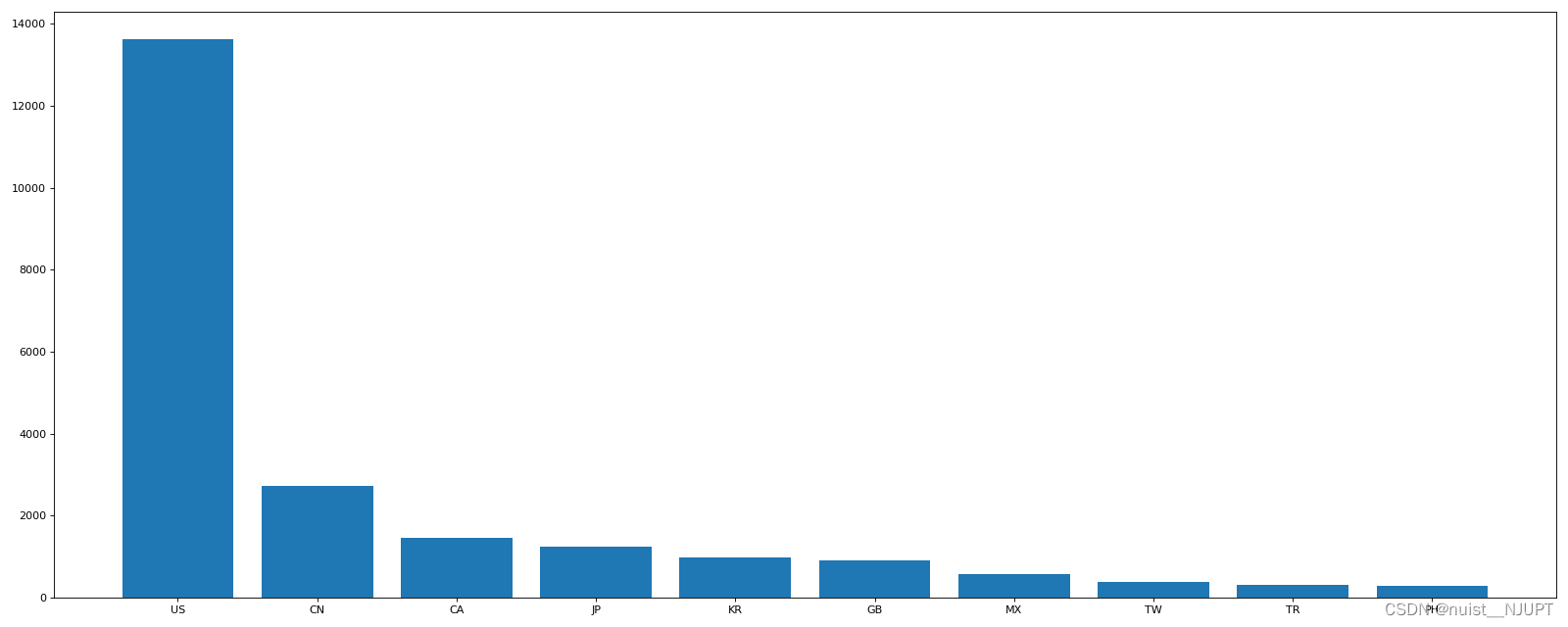目录
1-series和读取外部数据
我们知道在python在使用numpy可以处理数值型数据,但是这是远远不够的,因为除了数值数据之外,还有字符串,时间序列等等,所以我们需要使用pandas进行处理;
pandas中常用数据类型:Series一维,带标签的数组;DataFrame二维,Series容器;
python代码如下:
import pandas as pd
t = pd.Series([1,2,31,12,3,4])
print(t)
print(type(t))
print("*" * 100)
#pandas生成一维带标签数组,并设置标签
t2 = pd.Series([1,23,2,2,1], index=list("abcde"))
print(t2)
print("*" * 100)
#pandas通过字典的方式创建Series数组
temp_dict = {"name":"xiaoming", "age":13, "tel":10086}
t3 = pd.Series(temp_dict)
print(t3)
print(t3[0]) #通过索引取值
print(t3["name"]) #通过键取值
print(t3[1:]) #取得连续的行
print(t3[[0,2]]) #取不连续的行
print(t3.index) #找到键
print(len(t3.index))#键的个数
print(t3.values)
print(type(t3.values))
print("*" * 100)
2-pandas的DataFrame
使用pandas读取外部数据,DataFrame和Series,前者二维,后者是一维,前者是后者的容器,我们看一下使用pandas读取文件,以及在pandas中创建DataFrame的过程,具体的代码如下所示:
import pandas as pd
import numpy as np
#pandas直接从当前文件夹下读取文件
p = pd.read_csv("./data/ratings.csv")
#dataFrame对象既有行索引,又有列索引
t = pd.DataFrame(np.arange(12).reshape((3,4)))
print(t)
print("*" * 100)
t1 = pd.DataFrame(np.arange(12).reshape((3,4)), index=list("abc"),columns=list("wxyz"))
print(t1)
print("*" * 100)
#pandas按字典创建dataFrame数组
d = {"name":["xiaoming", "xiaohua"], "age":[17, 18], "tel":[10086, 10010]}
t2 = pd.DataFrame(d)
print(t2)
print("*" * 100)
d2 = [{"name":"xiaoming","age":13,"tel":10086},{"name":"xiaohua","tel":10010},{"name":"xiaohong","age":19}]
t3 = pd.DataFrame(d2)
print(t3)
print("*" * 100)
#行索引
print(t2.index)
#列索引
print(t2.columns)
#值
print(t2.values)
print(t2.shape)#形状
print(t2.dtypes)#每一列的类型
print("*" * 100)
print(t3.head(1)) #显示前1行
print(t3.tail(1)) #显示最后一行
print("*" * 100)
print(t3.info()) #显示相关信息
print("*" * 100)
print(t3.describe()) #显示数字相关信息
print("*" * 100)对于统计的名字数据,我想知道哪些名字的使用次数比较高,那么使用pandas该怎么实现呢?显然我们需要进行排序处理,另外我们可以使用pandas进行取行和取列操作,具体代码如下:
import pandas as pd
import numpy as np
df = pd.read_csv("./data/dogNames2.csv")
#print(df.head())
#print(df.info())
#DataFrame中的排序方法
df = df.sort_values(by="Count_AnimalName",ascending=False)#降序排序
print(df[:20]) #取前20个
print("*" * 100)
print(df[:20]["Row_Labels"]) #取前20行的Row_Labels列
#df.loc通过标签索引行数据
t3 = pd.DataFrame(np.arange(12).reshape(3,4), index=list("abc"), columns=list("wxyz"))
print(t3)
print(t3.loc["a"]["z"]) #打印a行z列的数据
print(t3.loc[:]["y"]) #取列
print(t3.loc["a"][:]) #取行
print(t3.loc[["a","c"]]) #取多行
#df.iloc通过位置索引行数据
print(t3.iloc[1]) #取行
print(t3.iloc[:,[2,1]]) #取列
print(t3.iloc[1:,2:]) #取固定行列
我们继续学习bool索引和缺失数据的处理,有些时候需要对数据列进行多条件的筛选,那么就需要使用bool索引了,我们直接看代码吧:
import pandas as pd
import numpy as np
df = pd.read_csv("./data/dogNames2.csv")
#print(df.head())
#print(df.info())
df1 = df[(df["Count_AnimalName"] > 800) & (df["Count_AnimalName"] < 1000)] #找到大于800小于1000的
df2 = df[(df["Count_AnimalName"] > 800) | (df["Count_AnimalName"] < 1000)] #大于800或者小于1000的
print(df1)
print("*" * 100)
print(df2)
print("*" * 100)
#找到使用次数超过700且字符串长度大于4的狗的名字
print(df[(df["Count_AnimalName"] > 700) & (df["Row_Labels"].str.len()>4)])
print("*" * 100)
ts = np.arange(24).reshape(4,6).astype(float)
ts[[0,0,3],[0,5,2]] = np.nan
t3 = pd.DataFrame(ts, index=list("abcd"), columns=list("uvwxyz"))
print(t3)
print("*" * 100)
print(pd.isnull(t3)) #t3中的null值
print(pd.notnull(t3)) #t3中的非null值
print("*" * 100)
print(t3.dropna(axis=0,how="all")) #删除当前行全为null的
print(t3.dropna(axis=0,how="any")) #删除当前行存在为null的
print("*" * 100)
print(t3.fillna(100)) #NAN位置填充100
print("*" * 100)
#t3.dropna(axis=0,how="any",inplace=True) #inplace原地修改
#print(t3)
#rint("*" * 100)
print(t3.fillna(t3.mean())) #填充均值
t3[t3==0] = np.nan #认为0为缺失值可以赋值为nan
3-统计方法和字符串离散化
我们现在有2006年到2016年1000部最流行的电影数据,我需要知道这些电影数据中的电影评分的平均分,导演的人数信息,我们该怎么获取呢?我们使用pandas获取电影数据的评分均值,导演人数,演员人数,电影时长的最大值,最小值,均值等等。具体的代码如下所示:
vimport pandas as pd
df = pd.read_csv("./data/IMDB-Movie-Data.csv")
print(df)
print("*" * 100)
print(df.head(1))
print("*" * 100)
#获取评分
print(df["Rating"].mean())
#获取导演的人数
print(len(set(df["Director"].tolist()))) #用set集合去重
print(len(df["Director"].unique())) #用unique去重
print("*" * 100)
#获取演员的人数
temp_actors_list = df["Actors"].str.split(", ").tolist()
actors_list = [i for j in temp_actors_list for i in j]
actors_num = len(set(actors_list))
print(actors_num)
print("*" * 100)
#电影时长的最大值,最小值
max_runtime = df["Runtime (Minutes)"].max()
max_runtime_index = df["Runtime (Minutes)"].argmax()
min_runtime = df["Runtime (Minutes)"].min()
min_runtime_index = df["Runtime (Minutes)"].argmin()
median_runtime = df["Runtime (Minutes)"].median()
print(max_runtime)
print(max_runtime_index)
print(min_runtime)
print(min_runtime_index)
print(median_runtime)对于一组电影数据,如果我们想知道rating和runtime的情况,应该如何呈现数据呢?具体的过程如下所示:首先绘制运行时间的直方图,代码和绘制结果如下:
import pandas as pd
from matplotlib import pyplot as plt
df = pd.read_csv("./data/IMDB-Movie-Data.csv")
#数据准备
runtime_data = df["Runtime (Minutes)"].values
max_time = runtime_data.max()
min_time = runtime_data.min()
#计算组数
num_bin = (max_time - min_time) // 5
#设置图片大小
plt.figure(figsize=(20,8),dpi=80)
plt.hist(runtime_data,num_bin)
plt.xticks(range(min_time,max_time+5,5))
plt.show()
4-数据的合并和分组聚合
对于一组电影数据,如果我们希望通过电影的分类情况,应该如何处理呢?我们看一下下面的源代码:
import pandas as pd
from matplotlib import pyplot as plt
import numpy as np
df = pd.read_csv("./data/IMDB-Movie-Data.csv")
print(df["Genre"].head(3))
#统计分类的列表
temp_list = df["Genre"].str.split(",").tolist()
gerne_list = list(set([i for j in temp_list for i in j]))
#构造全0的数组
zeros_df = pd.DataFrame(np.zeros((df.shape[0],len(gerne_list))),columns=gerne_list)
#每个电影出现分类的位置赋值1
for i in range(df.shape[0]):
zeros_df.loc[i,temp_list[i]] = 1
#统计每个分类的电影数量和
gerne_count = zeros_df.sum(axis=0)
print(gerne_count)
#排序
gerne_count = gerne_count.sort_values()
_x = gerne_count.index
_y = gerne_count.values
#画图
plt.figure(figsize=(20,8),dpi=80)
plt.bar(range(len(_x)),_y)
plt.xticks(range(len(_x)),_x)
plt.show()

下面我们看一下数据合并值join,默认情况下,把行索引相同的合并到一起。还有merge的使用,具体如下代码所示:
import pandas as pd
from matplotlib import pyplot as plt
import numpy as np
df1 = pd.DataFrame(np.ones((2,4)),index=["A","B"],columns=list("abcd"))
print(df1)
print("*" * 100)
df2 = pd.DataFrame(np.zeros((3,3)),index=["A","B","C"],columns=list("xyz"))
print(df2)
print("*" * 100)
print(df1.join(df2))
print("*" * 100)
print(df2.join(df1))
print("*" * 100)
df3 = pd.DataFrame(np.arange(9).reshape(3,3), columns=list("fax"))
print(df3)
print("*" * 100)
print(df1.merge(df3,on="a"))
print("*" * 100)
print(df1.merge(df3,on="a",how="inner"))
print("*" * 100)
print(df1.merge(df3,on="a",how="outer")) #并集
print("*" * 100)
现在我们有一组关于全球星巴克店铺的数据,如果我想知道美国的星巴克数量和中国的哪个多,或者我想知道中国的每个省份的星巴克数量情况,那我该怎么办呢?直接看代码吧:
import pandas as pd
from matplotlib import pyplot as plt
import numpy as np
file_path = "./data/starbucks_store_worldwide.csv"
df = pd.read_csv(file_path)
#调用聚合方法
grouped = df.groupby(by="Country") #按国家分组
coutry_count = grouped["Brand"].count()#按照品牌计数
print(coutry_count["US"])#美国的数量
print(coutry_count["CN"])#中国的数量
#统计中国每个省店铺的数量
china_data = df[df["Country"] == "CN"]
group = china_data.groupby(by="State/Province").count()["Brand"]
print(group)
#按照多个条件进行分组,返回Serier
groups = df["Brand"].groupby(by=[df["Country"],df["State/Province"]]).count()
print(groups) #得到的是带有两个索引的Series类型
print("*" * 100)
#按照多条件进行分组,返回DataFrame
group1 = df[["Brand"]].groupby(by=[df["Country"],df["State/Province"]]).count()
print(group1,type(group1))
下面我们学习一下pandas中的索引和复合索引的相关知识,具体的直接看代码就行,都加了注释的,具体如下:
import pandas as pd
from matplotlib import pyplot as plt
import numpy as np
file_path = "./data/starbucks_store_worldwide.csv"
df = pd.read_csv(file_path)
group1 = df[["Brand"]].groupby(by=[df["Country"],df["State/Province"]]).count()
#索引的方法和属性
print(group1.index)
df1 = pd.DataFrame(np.ones((2,4)),index=["A","B"],columns=list("abcd"))
df1.index = ["a","b"] #给索引赋值
print(df1)
#重新设置index
print(df1.reindex(["a","f"])) #取不到的值为NAN
print(df1.set_index("a",drop=False)) #将DataFrame的某一列作为索引,保留原列
a = pd.DataFrame({'a':range(7),'b' : range(7,0,-1),'c':['one','one','one','two','two','two','two'],'d':list("hjklmno")})
b = a.set_index(["c","d"]) #设置c,d为符合索引
print(b)
d = a.set_index(["d","c"])["a"]
print(d)
print(d.swaplevel()["one"]) #交换内外层索引位置,当想从内层索引取值的时候可以使用swaplevel()方法
print(b.loc["one"].loc["h"]) #根据索引定位
print(b.swaplevel().loc["h"]) #交换内外层索引后的取行操作
我们看一下下面的2个例子:
1-使用matplotlib呈现出店铺总数排名前10的国家;
2-使用matplotlib呈现出每个中国每个城市的店铺数量;
例子1的python代码如下:
import pandas as pd
from matplotlib import pyplot as plt
import numpy as np
file_path = "./data/starbucks_store_worldwide.csv"
df = pd.read_csv(file_path)
data1 = df.groupby(by="Country").count()["Brand"].sort_values(ascending=False)[:10]
_x = data1.index
_y = data1.values
plt.figure(figsize=(20,8),dpi=80)
plt.bar(range(len(_x)),_y)
plt.xticks(range(len(_x)),_x)
plt.show()绘制的图形如下:

例子2的python代码如下:
import pandas as pd
from matplotlib import pyplot as plt
import matplotlib
matplotlib.rc("font", family='YouYuan')
file_path = "./data/starbucks_store_worldwide.csv"
df = pd.read_csv(file_path)
df = df[df["Country"]=="CN"]
data1 = df.groupby(by="City").count()["Brand"].sort_values(ascending=False)[:25] #取前25个城市
_x = data1.index
_y = data1.values
plt.figure(figsize=(20,8),dpi=80)
plt.bar(range(len(_x)),_y,width=0.3,color='orange')
plt.xticks(range(len(_x)),_x)
plt.show()绘制的图形如下所示:

绘制横向条形图代码:
import pandas as pd
from matplotlib import pyplot as plt
import matplotlib
matplotlib.rc("font", family='YouYuan')
file_path = "./data/starbucks_store_worldwide.csv"
df = pd.read_csv(file_path)
df = df[df["Country"]=="CN"]
data1 = df.groupby(by="City").count()["Brand"].sort_values(ascending=False)[:25] #取前25个城市
_x = data1.index
_y = data1.values
plt.figure(figsize=(20,8),dpi=80)
plt.barh(range(len(_x)),_y,height=0.3,color='orange')
plt.yticks(range(len(_x)),_x)
plt.show()
我们现在有全球排名靠前的10000本书的数据,那么请统计一下下面的几个问题:
1-不同年份书的数量 ;
2-不同年份书的平均评分情况;
上述例子python代码如下:
import pandas as pd
from matplotlib import pyplot as plt
import matplotlib
matplotlib.rc("font", family='YouYuan')
file_path = "./data/books.csv"
df = pd.read_csv(file_path)
data1 = df[pd.notnull(df["original_publication_year"])] #找到非空的年份
group1 = data1.groupby(by="original_publication_year").count()["title"]
print(group1)
print("*" * 100)
#不同年份书的平均评分情况
group2 = data1["average_rating"].groupby(by=data1["original_publication_year"]).mean()
_x = group2.index
_y = group2.values
plt.figure(figsize=(20,8), dpi=80)
plt.plot(range(len(_x)),_y)
plt.xticks(list(range(len(_x)))[::10],_x[::10].astype(int),rotation=45)
plt.show()
绘制的图形如下:




























 被折叠的 条评论
为什么被折叠?
被折叠的 条评论
为什么被折叠?










